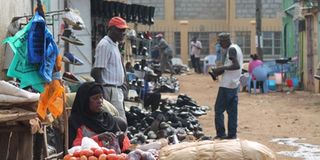Kakamega the poorest county in Kenya

Traders in Kakamega. PHOTO | ISAAC WALE |
What you need to know:
- The county’s poverty incidence stands at 49.2 per cent.
- More than 809,500 of its people live below the poverty line.
Kakamega is the poorest of the 47 counties, a new report says.
The Ministry of Devolution and Planning's report, ‘Socio-Economic Atlas of Kenya’ — which is based on the 2009 Kenya Population and Housing Census data — says Kakamega contributes 4.8 per cent to national poverty.
The county’s poverty incidence stands at 49.2 per cent.
More than 809,500 of its people live below the poverty line.
It is followed by Mandera — with 4.7 per cent poverty incidence (85.8 per cent) and 796,100 people living below the poverty line; Turkana 4.1 per cent, 87.5 per cent and 701,300 people; Nairobi 3.9 per cent, 21.8 per cent and 668,800 people; Bungoma 3.8 per cent, 47.3 per cent and 643,300 people.
Others are Kilifi with 3.7 per cent, 58.4 per cent and 636,000 people below poverty line; Kitui 3.5 per cent, 60.4 per cent and 591,600 people; Kisii 3.4 per cent, 51.4 per cent and 586,200 poor people; Makueni 3.1 per cent, 60.6 per cent and 529,200 people and Nakuru 3.1 per cent, 33.5 per cent and 523,600 people.
However, the report identifies the five counties that are making the lowest contribution to national poverty as Tharaka-Nithi at 0.9 per cent; poverty incidence (41 per cent) and 147,400 people living below the poverty line; Taita-Taveta 0.8 per cent, 50.4 per cent and 138,500 people; Kirinyaga 0.8 per cent, 25.9 per cent and 135,000 people; Isiolo 0.7 per cent, 65.3 per cent and 124,200 people and Lamu 0.2 per cent, 32.2 per cent and 31,800 people.
The report says poverty reduction strategies targeting poor areas must address issues and conditions of economic and social development that affect the whole area.
The report says counties that have a low poverty incidence but a very high poverty contribution, such as Nairobi and other major towns, require poverty reduction efforts that target poor people directly.




